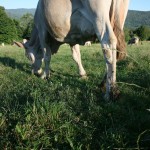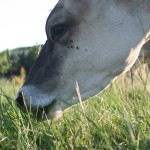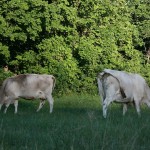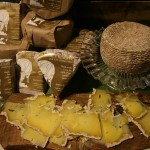written by Nicole Warren
At the farmer’s market every week, I get customers that ask me about FAT, and want to know the fat content of our cheese. Fat is a word that, in this society, has received a bad reputation. It is a misunderstood building block to life, in which all living things are made up of and rely on for nourishment.
In the creamery, we pull over the milk after the morning milking and start heating it in our vat. There is nothing done to it between that process. The pure raw whole milk from cows that are grazed on rapidly growing grass contains every essential vitamin and mineral in an easily absorbable form. The milk of grass-fed animals are rich in good fats, notably, omega-3 fatty acids, which have been found to reduce blood pressure, improve heart health, support a health mind for both function and a balanced mental state, and helps improve the body’s defense against fight cancer, balance hormones, and improve energy and stamina (Enig, 1999). These fats are absorbed into the body and utilized for energy, support adrenals and hormone production, and fat is utilized in almost every organ function in the body. The good fats found in grass-fed meat and dairy are not stored, but instead utilized. Consuming a lot of these animal fats prevents cancer, arthritis, supports the immune system response, heals the gut, and prevents mineral deficiencies, which are the root cause to degenerative diseases and mental imbalances.
Fats are essential for the proper absorption of fat-soluble vitamins and all minerals. When we consume fat with minerals, the absorption is slow and steady, which also keeps you full longer. In our raw milk, cheese, and butter from our pasture-raised cows, there are high amounts of Vitamin A, D, E and K as well as varying amounts of all essential minerals. In traditional societies that consumed dairy, butter, cheese, and seasonal milk was prized so highly for its nutrient content that is was given primarily to expecting mothers, nursing mothers, and children.
We make full-fat cheese, by which I mean we use whole milk fresh from the cow to make Maggie’s round, Tobasi, Cricket Creek Fresh and Berkshire Bloom. We allow our cheeses to age out and form a natural rind that we take care of in the aging rooms. Our cheese are made by hand and we are making them with the intention of nourishing our community. If you are ever in the area, we make cheese in the mornings on Monday, Tuesday, and Fridays and Wednesday we make butter. Stop by and take a look in the cheese room! We welcome you to watch our process.
As far as fat goes, I eat as much animal fats from our farm as possible – cream, butter, lard, tallow, egg yolks, cheese, and yoghurt. It sustains me all day long. I trust what the cow has to offer over what the industrial food system is producing. It has only been within a few generations that this mindset has changed, but the traditions of food are alive and well here on the farm.
For More Resources on good information on fats, check out these two websites:
Weston A Price Foundation, Real Milk
Or these great books:
Nourishing Traditions by Fallon & Enig, Fat: An Appreciation of a Misunderstood Ingredient by McLagan, The Grassfed Gourmet Cookbook by Hayes, Eat Fat, Lose Fat: The Healthy Alternative to Trans Fats by Enig, Gut and Psychology Syndrome: Natural Treatment for Autism, Dyspraxia, A.D.D., Dyslexia, A.D.H.D., Depression, Schizophrenia by Campbell-McBride




